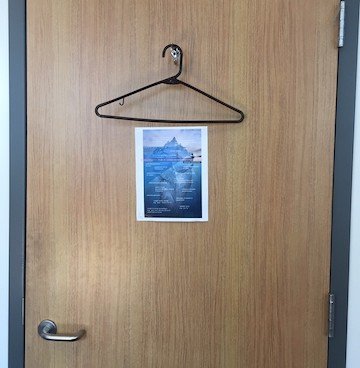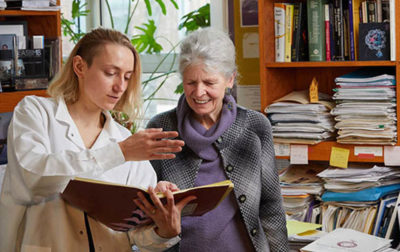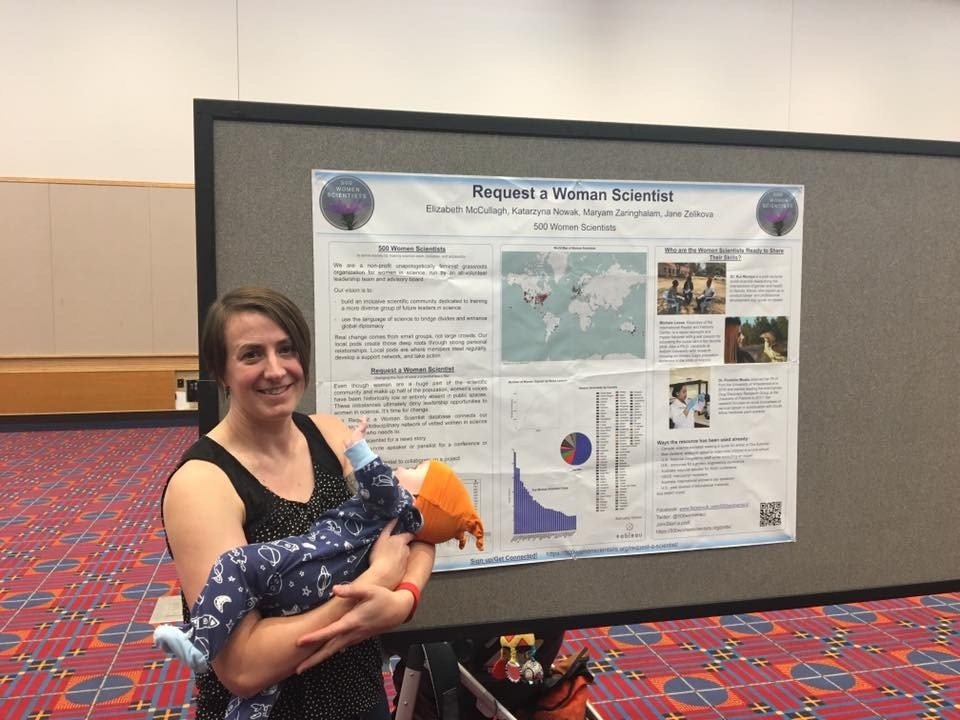On the door to her office at Johns Hopkins, Carol Greider, professor of molecular biology and genetics, taped up the image of an iceberg for all to see.

Carol Greider’s office door at Johns Hopkins showing the “iceberg diagram” of sexual harassment from the National Academies’ report
At the tip of the iceberg is a list of familiar forms of sexual harassment, such as threats and sexual assault. But what struck Greider, and the point of the graphic, which was part of a 2018 report from the National Academies of Sciences, Engineering, and Medicine, are all the less obvious, below-the-surface forms of harassment that women in science often endure — from being called derogatory names to being told that women don’t belong in science.
The National Academies report found that more than half of women faculty in science, engineering, and medicine departments, and between 20% and 50% of female graduate students, have experienced sexual harassment.
In the biological sciences, women hold only 29% of assistant professor jobs and 21% of full professor positions at the top-ranked research institutions in the United States, even though they earn more than half of the PhD degrees. Two things get most of the blame for the so-called “leaky pipeline”: unconscious bias — the inadvertent slights that keep women from getting promoted, receiving credit for important discoveries, being included in important meetings, and the like — and family-unfriendly workplaces. To be sure, Greider thinks these culprits are important. But sexual harassment could be a missing piece of the puzzle. “It was hard to understand why there is that big a leak [in the pipeline], but then reading the National Academies report, I thought, ‘Oh, that’s the giant gushing hole’ that I didn’t see before,” says Greider, a 2006 Lasker Basic Medical Research laureate and winner of the 2009 Nobel Prize in Physiology or Medicine.
Jolting awareness
Without a doubt, women have come a long way in biological sciences since they first started getting faculty positions in the 1960s following the women’s movement, the civil rights movement, and affirmative action policies, notes Nancy Hopkins, a biology professor who was hired by MIT in 1973. There are signs of progress in the fact that women are getting at least half of science PhD degrees and are heading up biology departments, major universities, and even the National Academy of Sciences. Nevertheless, “it is not as fast as we would have thought, and faculty turnover is slow,” Hopkins says.

Nancy Hopkins on the MIT campus around the time the 1999 MIT report came out about the marginalization of women science faculty at the school
According to Hopkins, “it seems as if every 20 years, you need a jolt to really make some progress.” She thinks there is a new jolt surging, and it is because of the recent National Academies report on sexual harassment, as well as the #MeToo movement to support sexual violence survivors. There are also now #metoostem and #metoohealth websites and social media groups that support those who experience sexual harassment.
Nancy Hopkins can take credit for a major jolt herself, back in the mid-1990s, when she and fellow Massachusetts Institute of Technology (MIT) biology professor Mary-Lou Pardue conducted a survey of the 17 tenured women professors in the MIT School of Sciences. (At the time, there were 194 tenured men faculty.) The report came out in 1999 in the MIT Faculty Newsletter and detailed how nearly all of these women experienced what is now commonly called unconscious bias. They felt marginalized and cut off from resources and positions of responsibility and power, even though many of them said they had been treated fairly as junior faculty. Hopkins suspects the issue may not be as bad for junior women faculty because, as she said, “the men who are in power are sympathetic to young women who are vulnerable.”
It took Hopkins about two decades after she joined MIT to realize it was happening to her, too. She blamed herself for not being good enough, she allowed male faculty and their team members to take her lab materials, and she accepted when her request for more lab space was denied even though she knew she had less space than junior male faculty. (She went to all the labs with a tape measure.) The final straw was when Hopkins had an important course that she developed taken away and given to male faculty. “When I did finally wake up, I was very upset because I realized how much of my life had been wasted, in a way,” Hopkins said. So she and Pardue, who had many similar experiences, embarked on their survey — which they conducted in secret at first, out of fear of retaliation.
When Hopkins and Pardue started discussing their findings, the president of MIT at the time and other university leadership took notice. And they took action, changing hiring policies and appointing women faculty to department chairs and other important positions. In addition, the president created the MIT9, a group of 9 universities that went on to carry out similar studies on the state of women faculty in science and engineering.
Identifying stereotype threat
Today, the gender imbalance is “so much better” than a few decades ago, said Joan Steitz, who is a professor of molecular biophysics and biochemistry and was awarded the Lasker~Koshland Special Achievement Award in Medical Science in 2018. When Steitz joined the faculty of Yale University in 1970, she knew of only one or two other women professors of molecular biology in the entire country.
Fortunately, Steitz had supportive men as advisors and department heads early in her career, but she now realizes how much she was affected by what psychologists call stereotype threat. In situations where a person feels like an undervalued minority, they undergo physiological and cognitive changes such as increased blood pressure and memory problems. “It has explained to me a lot of my own behavior where I would be on important committees, especially in the 1980s and 1990s, and I would always be the only woman, and there would be 10 men and I wouldn’t dare say anything,” Steitz recalls.

Joan Steitz meets with Paulina Pawlica, a postdoc in her lab. Steitz says it is only fair that excellent women scientists have the same opportunities as their male peers.
“If we could get to 30% or 35% women in faculty positions in science, I think we’d be doing very well,” Steitz said. If there were any doubt that unconscious bias still keeps women from getting to that one-third mark, a 2007 National Academies report, which Steitz helped put together, reviewed data from some of the MIT9 universities and concluded that unconscious bias against women in science remains prevalent.
Combining parenting and science
For many women scientists, juggling their career and parenting is the biggest barrier. According to research, married women with children are 35% less likely to have tenure-track positions than married men with children, a difference that experts think can be chalked up to believing it would be too daunting to enter academia as the primary parent.
One of the biggest challenges for Elizabeth McCullagh, who is a neuroscience post-doc at the University of Colorado Anschutz, was not getting any paid leave time when her daughter was born. Although the university recently created paid parental leave policies for graduate students, faculty, and staff, she said post-docs were left out because of complications with the grants that support them. And when employees at the medical campus are ready to go back to work, there is no access to affordable day care, McCullagh said.

Elizabeth McCullagh stands next to her poster at the Science Talk conference in 2018 with her baby. The poster was about the Request a Woman Scientist project that McCullagh created with 500 Women Scientists.
“I always felt like I was an advocate for women in STEM, but I had no idea how much these things are challenges that people just do not even really talk about,” said McCullagh, who is part of the leadership of 500 Women Scientists, an organization that advocates for women and minority scientists. The group wrote an open letter they will soon be submitting to the National Science Foundation and National Institutes of Health urging institutions across the board to provide paid parental leave and to make their policies clear. McCullagh also helped co-found a group called Milk and Cookies, which provides lactation support for parents at the university.
Despite her challenges, McCullagh and her husband are starting faculty positions at Oklahoma State University next year and are expecting their second child. Staying in academia has been about perseverance, she says. “I think a lot of it is just being stubborn and saying, ‘I’m not going to give up because this is hard, and it shouldn’t be this hard.’”
by Carina Storrs
Don’t miss the June Newsletter, “Stopping the Leaks” that will discuss initiatives to improve gender equity and promote diversity in science.
